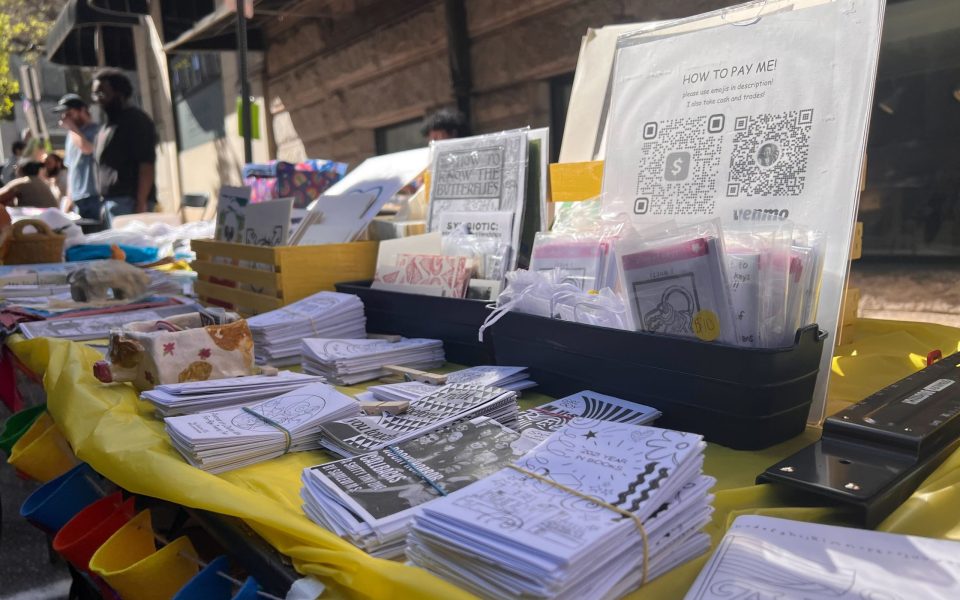Featured photo: Zines on display at UNCG’s Fold Under Pressure Zine Fair on April 20. (photo by Autumn Karen)
“How about we make something good?” 5-year-old Joseph Burello asks artist Jason Lord at the Greensboro Project Space at 111 February One Place on April 20.
They sit before a table littered with various kinds of paper, surrounded by Lord’s MFA exhibition. Creating book materials with the community was always part of the vision for the exhibition through Lord’s artistic spellbook project. Partnering with the Zine Fair proved to be a perfect way to engage with the community.
“Zines are a fun and easy way for people to access creativity,” said Lord, an MFA art student at UNCG. “It’s inexpensive to make one with one page of paper.”
Lord helps young Burello fold a sheet of paper into the book-like zine configuration, then color on the pages. Nearby, Burrello’s parent Remy smiles and folds their own.
“I thought it was a great idea to bring him out,” Remy says. “I made my own printed stuff when I was younger and I really want my son to see lots of different ways to be creative.”

Remy likes how events like this Fold Under Pressure Zine Fair, organized by UNCG’s Visual Art and Humanities Librarian Maggie Murphy, give kids and adults alike the opportunity to understand the creative community from lots of different angles.
According to Murphy, zines are an example of grassroots communication.
A zine is a small, self-published work that’s usually centered around personal experiences or causes. Often printed on regular letter paper and folded or hand copied, zines focus on giving voice to individual perspectives. At Fold Under Pressure, zines in art, poetry, non-fiction, fiction, political commentary, music and beyond covered the tables, inviting readers to engage with ideas and spark their own creativity.
Murphy organized the event to introduce the people of Greensboro to zines and to give students a chance to show off what they’ve been working on.
While zines have made a comeback in recent years, the history of the art dates back decades, if not centuries. By some measures, Thomas Paine’s Common Sense was a zine, published famously in 1775. Over the years, zines grew to be a covert way to spread important information for underrepresented communities. Historians trace some origins to the Harlem Renaissance through the emergence of pulp magazines in the thirties and into the counterculture movement of the sixties. Because zines are outside of the confines of mainstream publishing, creators are free to play, invent, connect with and challenge readers. Alternative viewpoints and traditionally marginalized voices have long found a platform in zines.
Now there’s this big buzz for zines that’s being reinvigorated by young people.
Buttons with slogans like “Pizza Rolls not Gender Rolls” and “Listen to Black Women” are spread out over the table from the Womens, Gender and Sexuality Studies Program at UNCG. Behind the buttons are baskets holding dozens of zines like “Deadly Dull, Issue No. 1” and “No Means No.”

Members of the WGSS said that the key to zines is that they’re passed around communities, creating connections.
“It has a lot of great history as a way to get information out, ” says Alyssa Cavalieri of her work with zines and the WGSS. “Especially about stuff related to gender and sexuality”
WGSS boasts a large display of their zine assemblage, though their entire collection was too massive to bring out to the event. The bulk of them live in UNCG’s Curry Building in the third floor WGSS lounge, open for browsing. Besides checking out zines, students can go to the space to work, hang out and get clothing from their clothes closet.
Tim Curry as Dr. Frank-N-Furter smiles from the black and white cover of “Rocky Horror Callbacks: A S**ty Tiny Zine” on Sam Levi’s table. Inside the folded pages from a black and white printer are stacked lines of observations and experience in the wild world of floor shows.

“I’ve been making zines since I was in high school,” says Levi. “It’s DIY and very accessible. You just use your printer and do the thing.”
Levi was invited by Murphy when they both attended the Chapel Hill/Carrboro Zine Fest and helped organize that fair, as well as others. One major event in the area, the Greensboro Zine Fest has been dark for five years thanks in large part to the challenges of the pandemic. This year, it returns July 28 to the Crowne at Carolina Theater.
“We have more than 70 applications for entry so far,” says Greensboro Zine Fest organizer Tristin Miller in a phone interview.
With so many creators wanting to participate, this year’s fest will include a curated stable of artists, rather than filling up on a first come, first serve basis. Miller is a longtime event planner and artist in their own right, but putting together the Greensboro Zine Fest is a particularly important passion for them.
“I’m excited to see the community is ready for zines,” Miller says.
You can learn more about the Greensboro Zine Fest 2024 on their website at gsozinefest.com
Join the First Amendment Society, a membership that goes directly to funding TCB‘s newsroom.
We believe that reporting can save the world.
The TCB First Amendment Society recognizes the vital role of a free, unfettered press with a bundling of local experiences designed to build community, and unique engagements with our newsroom that will help you understand, and shape, local journalism’s critical role in uplifting the people in our cities.
All revenue goes directly into the newsroom as reporters’ salaries and freelance commissions.


Leave a Reply